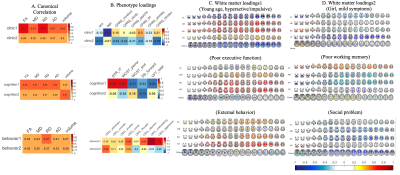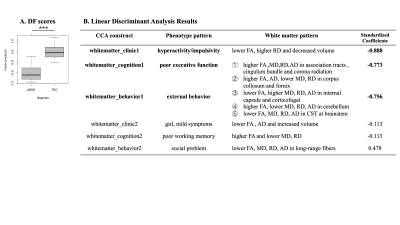Xuan Bu1,2, Yingxue Gao1, Kaili Liang1, Weijie Bao1, Lu Lu1, Ying Chen1, Lanting Guo3, Qiyong Gong1, Susumu Mori2, and Xiaoqi Huang1
1Radiology Department, Sichuan University, Chengdu, China, 2The Russell H. Morgan Department of Radiology and Radiological Science, Johns Hopkins University School of Medicine, Baltimore, MD, United States, 3Psychiatry Department, Sichuan University, Chengdu, China
1Radiology Department, Sichuan University, Chengdu, China, 2The Russell H. Morgan Department of Radiology and Radiological Science, Johns Hopkins University School of Medicine, Baltimore, MD, United States, 3Psychiatry Department, Sichuan University, Chengdu, China
Complex ADHD phenotypes are associated with specific patterns of abnormal white matter microstructure during brain development

Figure
1. Canonical correlations (A) and loadings (B-D) for each analysis. Colors show
the loading strength of phenotype (B) and white matter (C, D) measures on their
respective latent variates for each canonical correlation analysis. Warmer
colors indicate stronger positive loadings (higher values on an individual
measure); cooler colors indicate stronger negative loadings (lower values on an
individual measure). For clarity, loadings between -0.2 and 0.2 are shown in
white.
